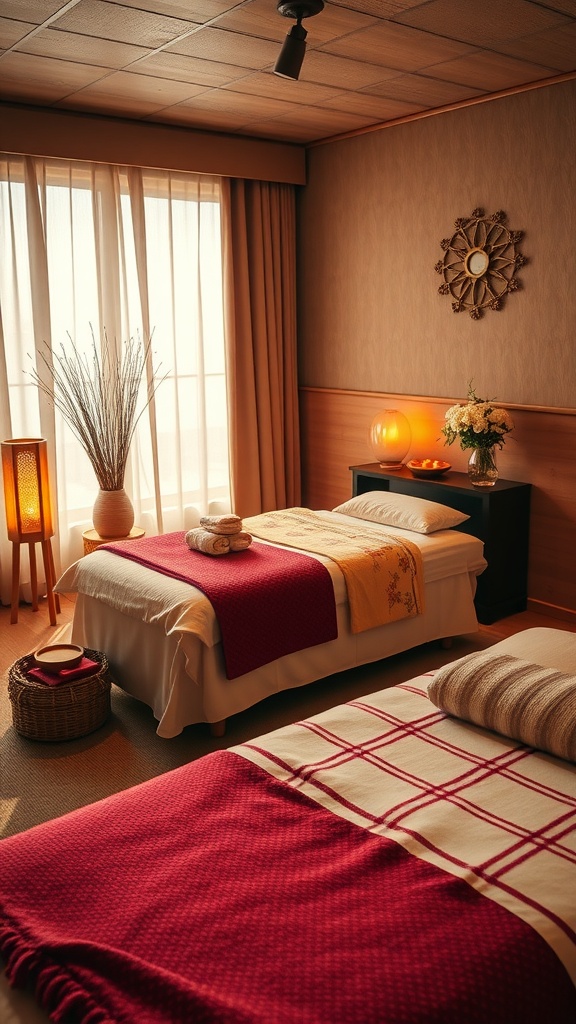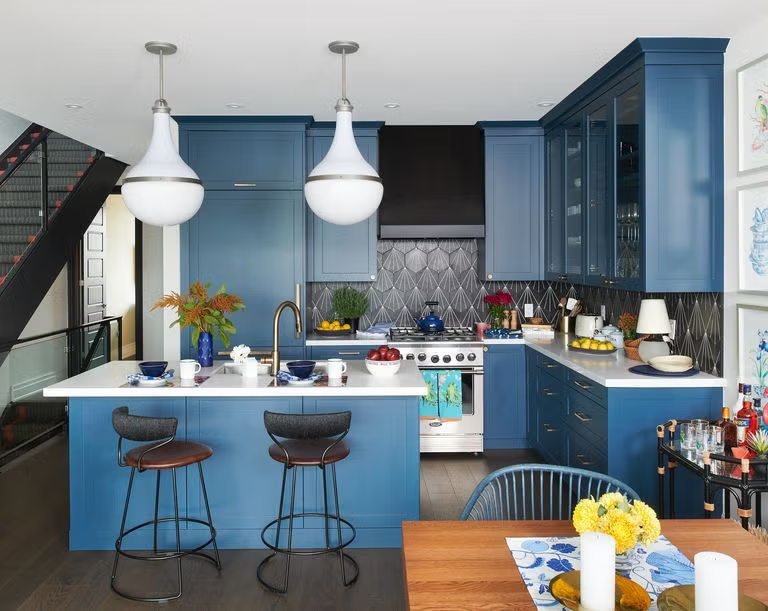15 Japandi Dining Room Design Ideas to Elevate Your Space
Japandi style—a harmonious blend of Japanese minimalism and Scandinavian functionality—has taken the interior design world by storm. It’s the perfect fusion of warm, natural elements with clean lines and understated elegance. If you’re looking to create a dining room that feels serene, inviting, and effortlessly stylish, Japandi dining room design might just be your new best friend.
This article will guide you through 15 stunning Japandi dining room design ideas that balance simplicity with sophistication. Each concept is detailed to help you envision how you can bring this aesthetic into your home. Whether you’re starting fresh or refreshing your space, these ideas are crafted with the modern woman in mind, combining practicality and beauty to make your dining room a place you’ll love to gather.
1. Natural Wood Dining Table
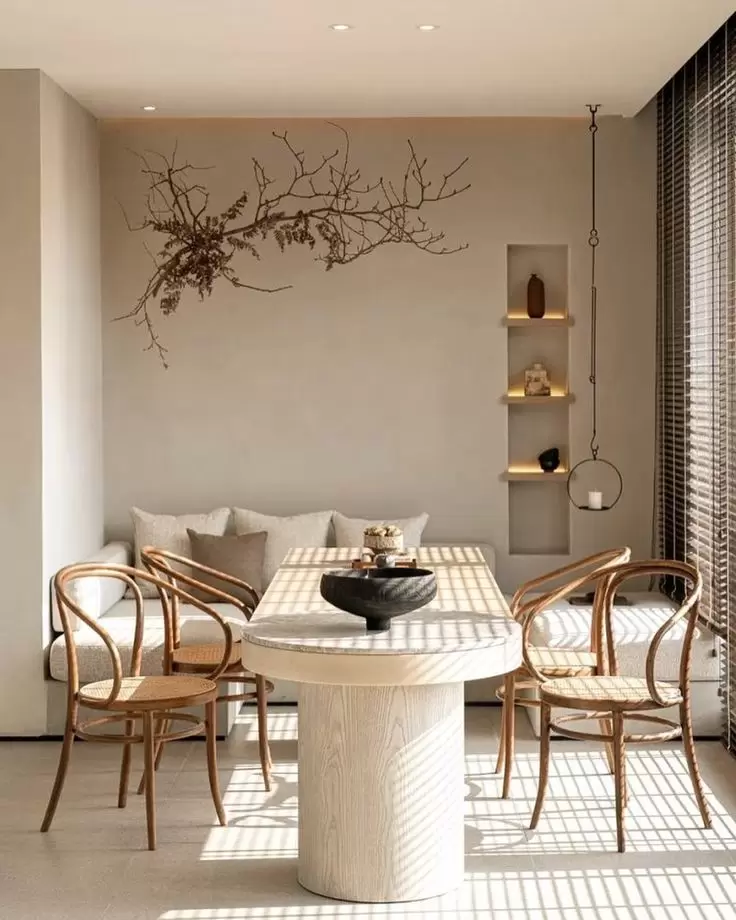
At the heart of any Japandi dining room lies a natural wood dining table—simple, sturdy, and crafted with impeccable care. The beauty of a solid wood table, preferably in light oak or walnut, is that it embodies the warmth and organic charm both Japanese and Scandinavian designs cherish.
Natural wood tables are not just furniture pieces; they are statement anchors in the room. Their smooth, clean surfaces invite you to run your hand along the grain, while the subtle imperfections—knots or varied textures—celebrate the authenticity of the material.
Pair this with minimalist chairs, perhaps in muted tones or featuring simple upholstery, to enhance the calm, uncluttered vibe. The organic appeal of wood combined with a sleek silhouette achieves the perfect balance between rustic charm and modern simplicity.
Wood furniture also promotes sustainability, an important value in both design traditions. Opting for reclaimed or responsibly sourced wood adds an ethical touch to your decor.
The natural hues and textures of the wood bring warmth to the space, helping to create a cozy yet airy dining area where family and friends can comfortably linger.
2. Neutral Color Palette

Japandi style thrives on a serene and neutral color palette that soothes the senses and creates an airy ambiance. Think soft beiges, creamy whites, gentle greys, and muted earth tones that bring a sense of calm and balance.
This muted color scheme is essential for achieving the minimalist, uncluttered aesthetic that defines Japandi interiors. It allows the natural textures and materials, like wood and linen, to take center stage without overwhelming the space.
By focusing on these neutral shades for walls, flooring, and larger furniture pieces, you create a flexible backdrop that welcomes accent colors subtly through decor pieces or natural greenery.
Moreover, neutral tones brighten your dining room by reflecting natural light, making the space feel larger and more open—a key element in modern dining rooms.
A neutral base also makes it easier to incorporate modern back porch ideas or back porch decor if you extend the Japandi style to outdoor living spaces connected to your dining area.
3. Minimalist Lighting Fixtures
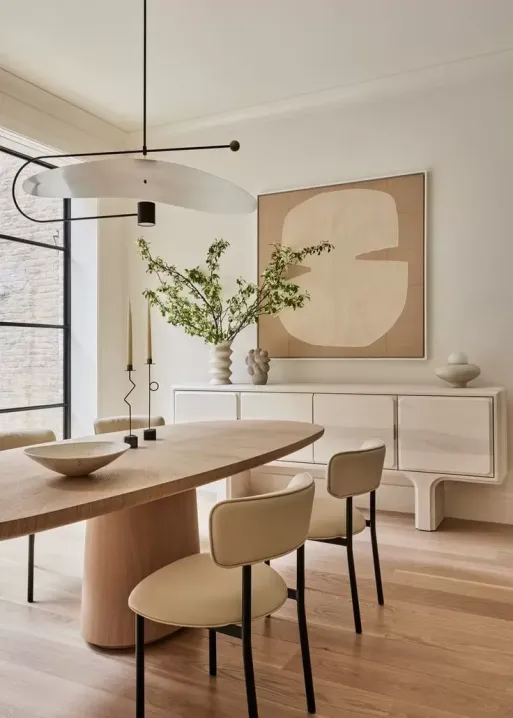
Lighting in Japandi dining rooms is intentionally minimal, designed to enhance the peaceful atmosphere without drawing too much attention. Choose fixtures with clean lines, natural materials, or handcrafted details to complement your overall design.
Paper lanterns or pendant lights made from rice paper, bamboo, or rattan beautifully merge Japanese tradition with Scandinavian simplicity. These fixtures diffuse light softly, creating an inviting glow perfect for dining and relaxing.
Simple, geometric designs in matte black, muted brass, or wood finishes also work well, giving your dining room an elegant, modern touch.
Consider layering your lighting with dimmable ceiling lights and smaller table lamps or candles to add depth and warmth without cluttering the room.
Minimalist lighting helps maintain the open, airy feel of the space while emphasizing the organic and tactile elements essential to Japandi.
4. Functional, Comfortable Seating
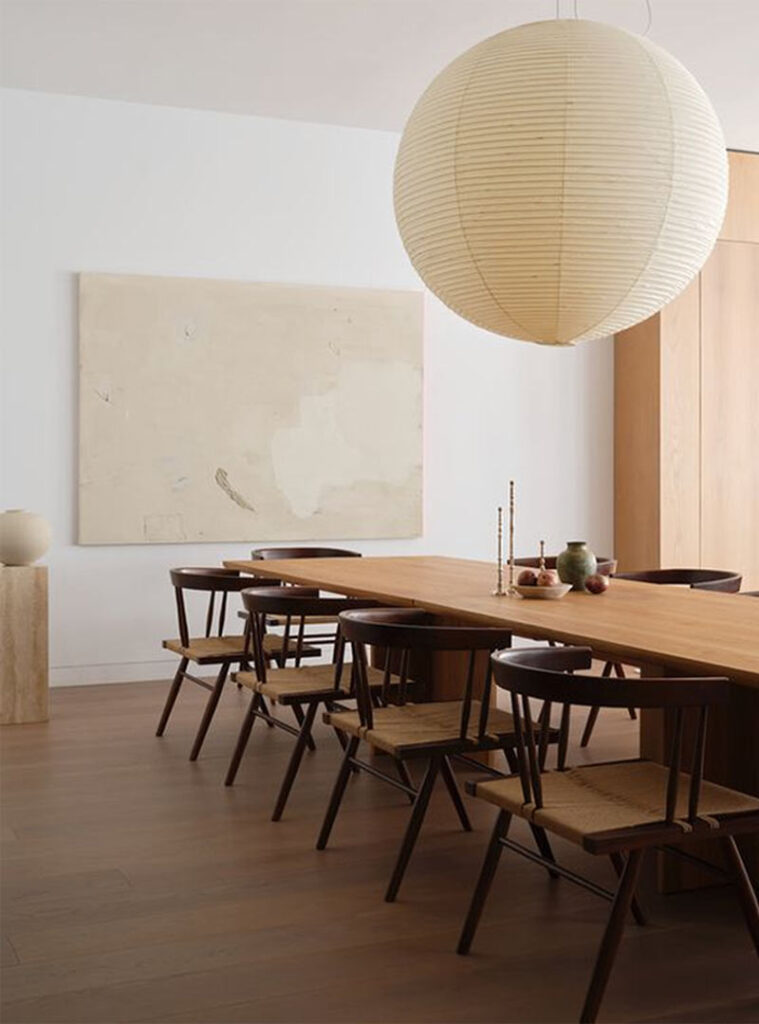
Comfort is king in a Japandi dining room. The seating should be simple yet supportive, inviting long conversations and relaxed meals.
Opt for chairs or benches with soft cushions in natural fabrics like linen or cotton in neutral tones. These fabrics not only feel pleasant against the skin but also enhance the tactile experience of the room.
Wooden frames in natural finishes echo the dining table, promoting visual harmony.
Choose ergonomic designs with subtle curves for a Scandinavian-inspired softness that balances the Japanese linearity.
Benches are a popular choice in Japandi design because they maximize space and encourage communal dining—a perfect way to nurture connection and warmth.
Comfortable seating that blends form and function ensures your dining area is both aesthetically pleasing and practically inviting.
5. Textured Natural Rugs
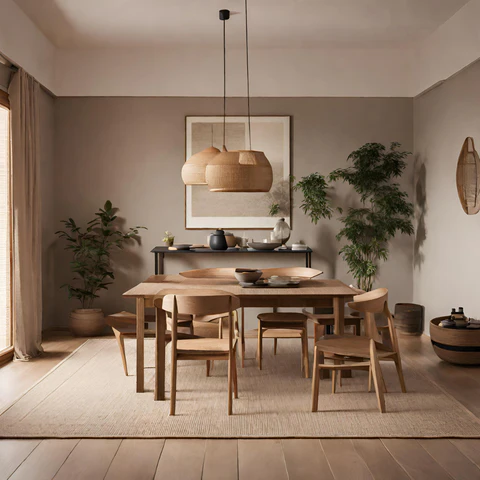
Adding a textured natural rug under your dining table grounds the space while enhancing the Japandi connection to nature.
Look for rugs crafted from organic fibers like jute, sisal, or wool in muted tones. These materials introduce warmth and tactile interest without overwhelming the minimalist look.
A simple woven pattern or flatweave design complements the clean lines of the furniture and reflects the subtle beauty found in Japanese textiles and Scandinavian weaving traditions.
Natural rugs are durable and easy to clean—perfect for a dining area where spills can happen but style cannot be compromised.
The rug softens hard flooring, provides comfort underfoot, and visually defines the dining zone in an open floor plan.
6. Greenery and Bonsai Plants
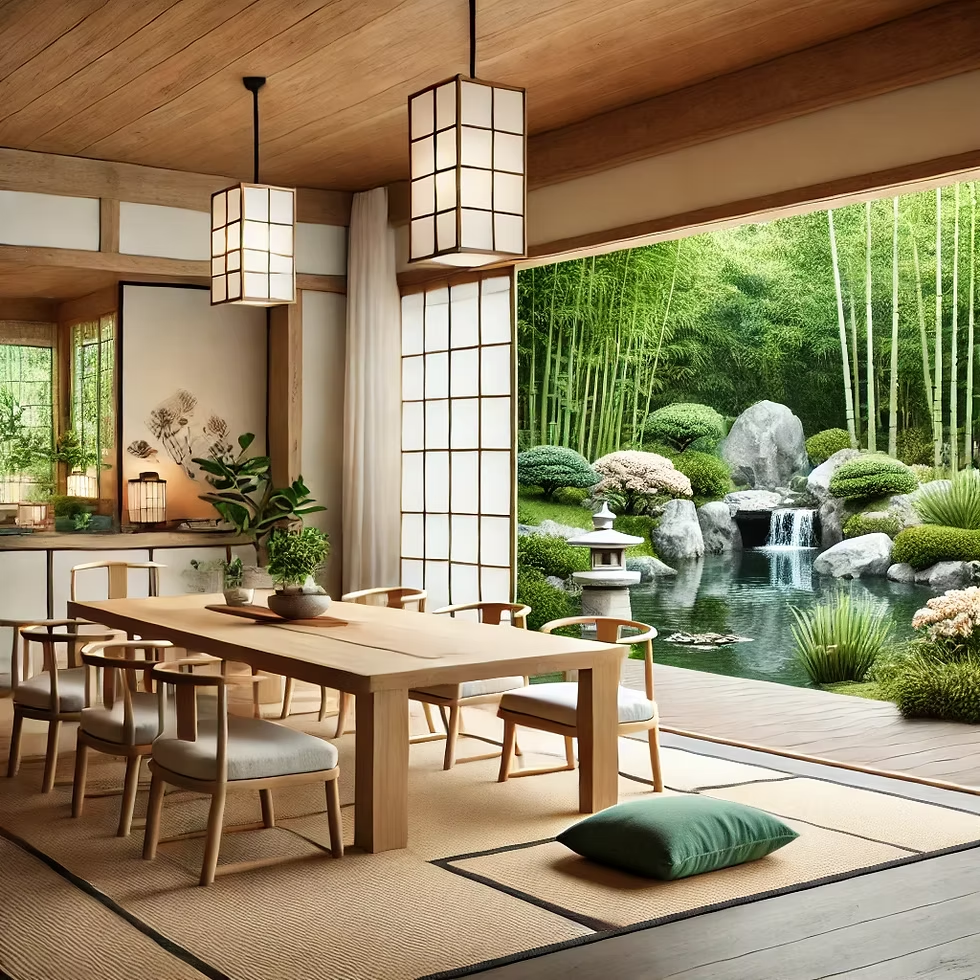
Bringing the outdoors inside is a key principle in Japandi interiors, making greenery an essential part of your dining room design.
Incorporate simple potted plants or elegant bonsai trees to add life and freshness to the room without cluttering it.
Bonsai trees, in particular, reflect Japanese culture and emphasize mindfulness and care, reinforcing the calming Japandi vibe.
Choose plants with simple shapes and muted greens to maintain the understated aesthetic.
Use minimalistic ceramic or clay pots in neutral shades to blend with your color palette and materials.
Plants also improve air quality and bring a sense of tranquility—perfect for creating a dining environment where everyone feels relaxed and connected to nature.
7. Open Shelving with Curated Decor
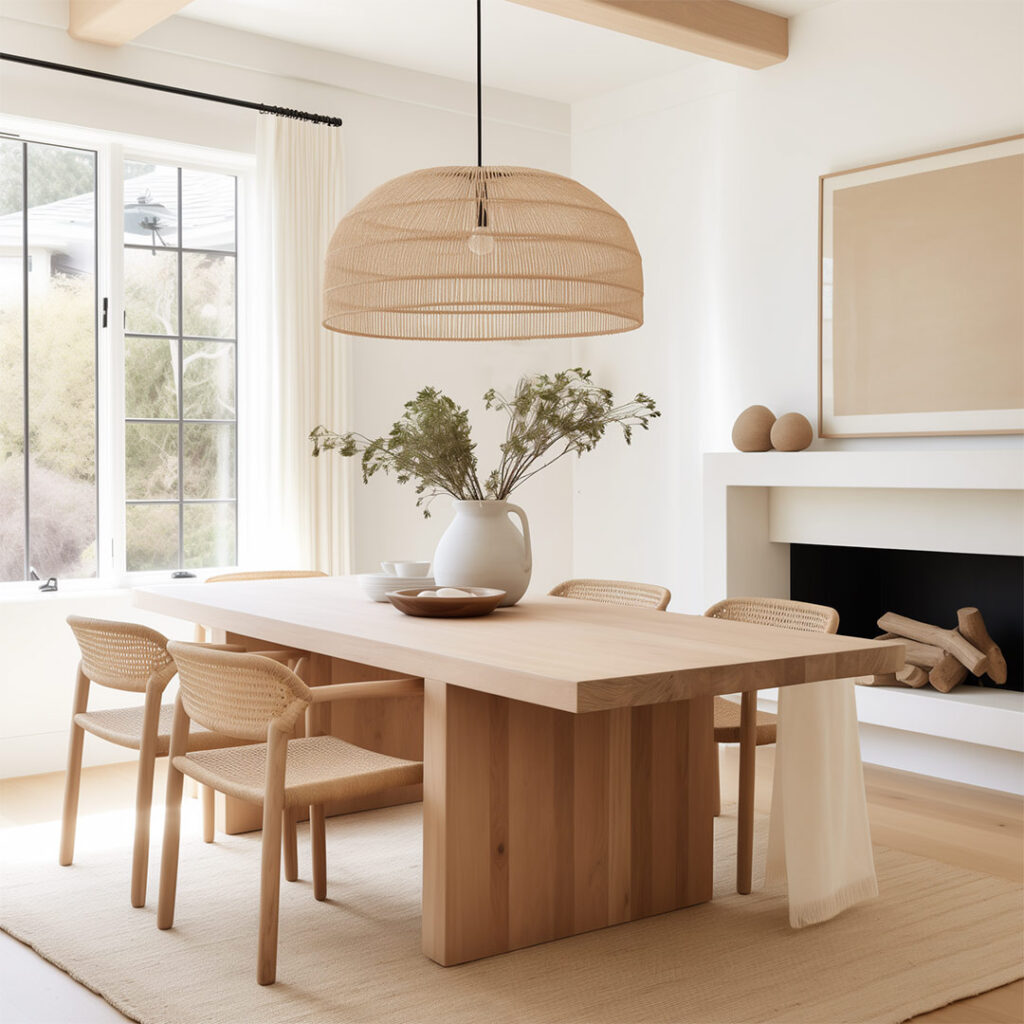
Open shelving is a smart addition to a Japandi dining room, offering both storage and a chance to showcase meaningful items without overwhelming the space.
Choose wooden shelves with simple, clean lines that echo your dining table and seating.
Curate the shelves with a mix of functional and decorative pieces—think handcrafted ceramics, natural fiber baskets, and minimalist pottery.
Avoid overcrowding; instead, opt for a few carefully selected items that reflect your style and values, keeping the overall look airy and intentional.
Shelving also provides an opportunity to display modern back porch decor or outdoor living accents if your dining space connects to outdoor areas, creating visual continuity.
This approach emphasizes quality over quantity, a core philosophy of Japandi design.
8. Simple Window Treatments
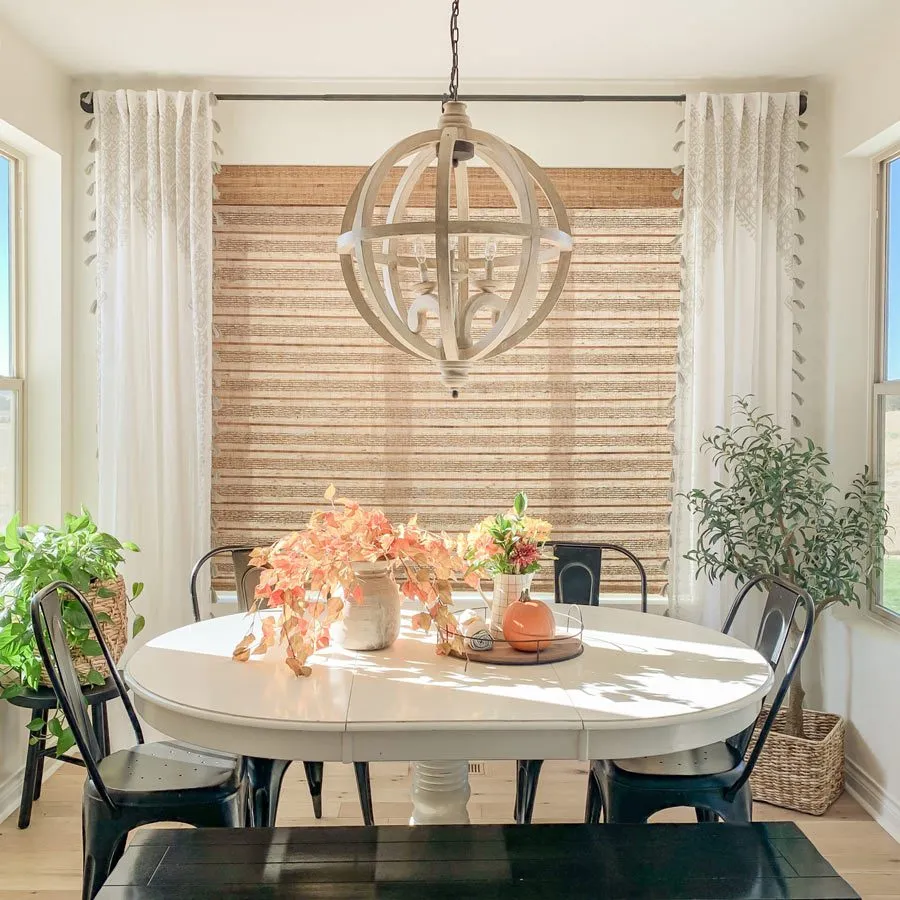
To keep the dining room light and airy, opt for simple window treatments that offer privacy without sacrificing natural light.
Linen or cotton curtains in neutral tones work beautifully, filtering sunlight softly while adding texture and warmth.
Alternatively, natural bamboo or wooden blinds blend perfectly with the wood elements and provide a subtle Japanese influence.
Avoid heavy drapes or bold patterns, which can disrupt the calm and minimal aesthetic.
Simple treatments allow your dining room to stay connected to the outdoors, reinforcing the Japandi commitment to natural elements and light.
They also provide a gentle backdrop to the rest of your decor, making the space feel open, inviting, and uncluttered.
9. Low-Profile Furniture
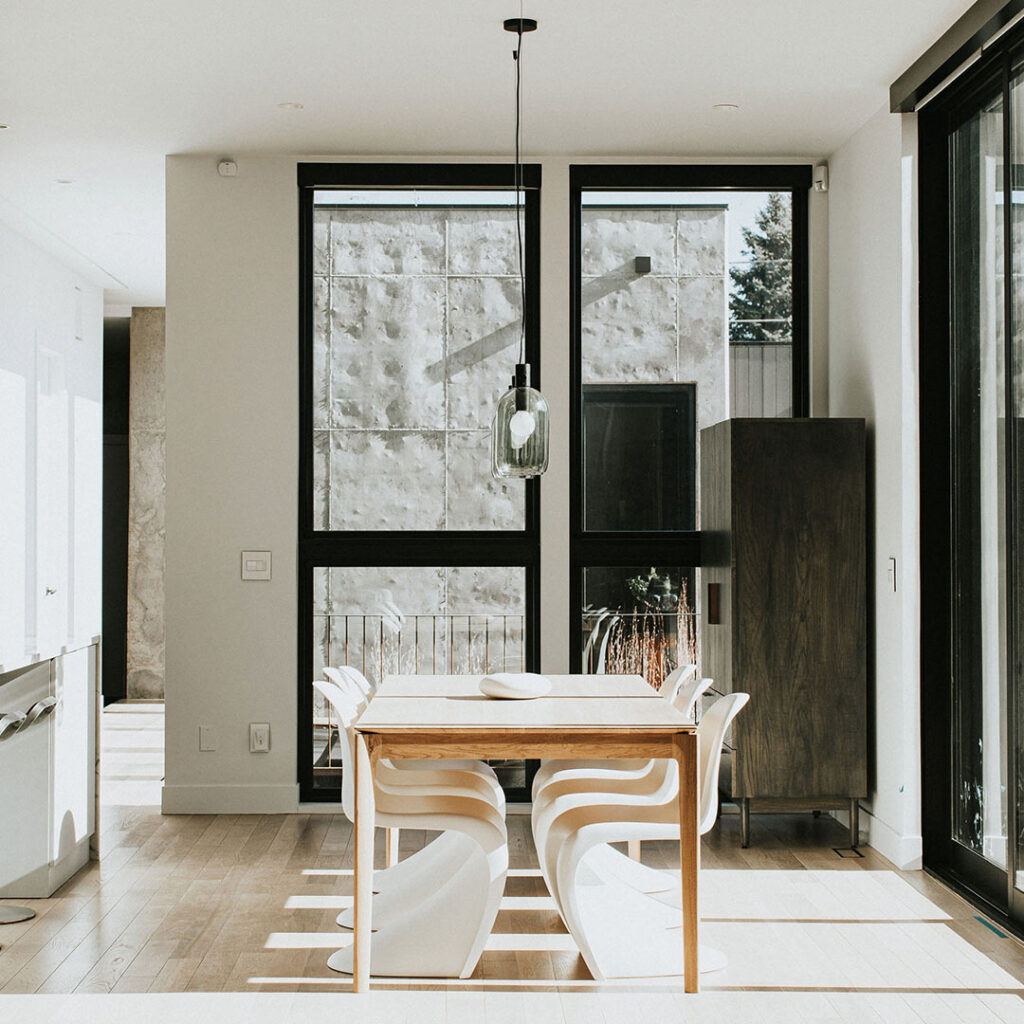
Low-profile furniture is a hallmark of Japanese design, emphasizing grounding and closeness to nature. In a Japandi dining room, this means opting for dining tables and chairs that sit lower than typical Western styles.
This approach creates a sense of intimacy and calm, making meals feel like a mindful ritual rather than a rushed activity.
Low seating encourages relaxed postures and closer connection among diners, embodying the Japandi values of simplicity and connection.
Pair these pieces with soft cushions or tatami-style mats for extra comfort, blending Scandinavian softness with Japanese tradition.
Beyond aesthetics, low-profile furniture keeps the room feeling spacious and uncluttered, supporting that clean, airy vibe Japandi is known for.
10. Handmade Ceramics and Tableware
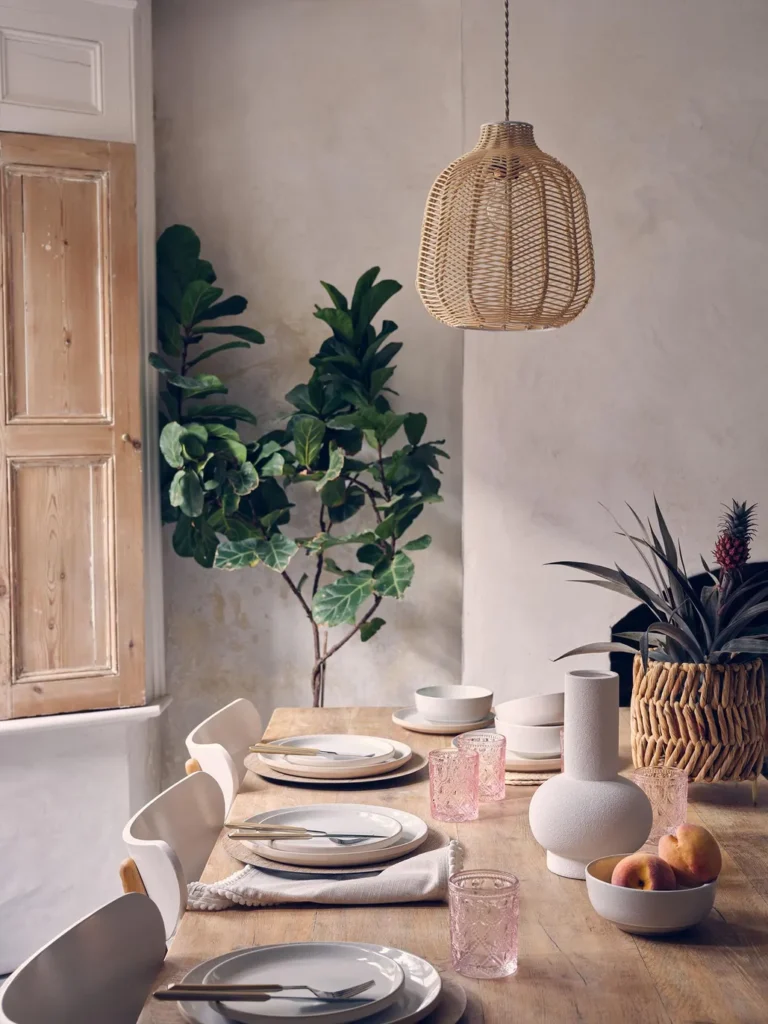
In Japandi dining rooms, tableware isn’t just functional — it’s art.
Handmade ceramics with subtle imperfections reflect the Japanese concept of wabi-sabi, the beauty of imperfection, and add warmth to the dining experience.
Opt for simple, earthy colors such as soft whites, muted blues, or natural clay tones to complement your neutral palette.
These artisanal pieces can be displayed on open shelving or used daily to elevate your meals.
Their tactile nature and organic shapes contrast beautifully with the clean lines of your furniture, adding depth and personality without clutter.
Using handmade ceramics aligns perfectly with Japandi’s focus on quality, craftsmanship, and mindful living.
11. Textured Wall Finishes
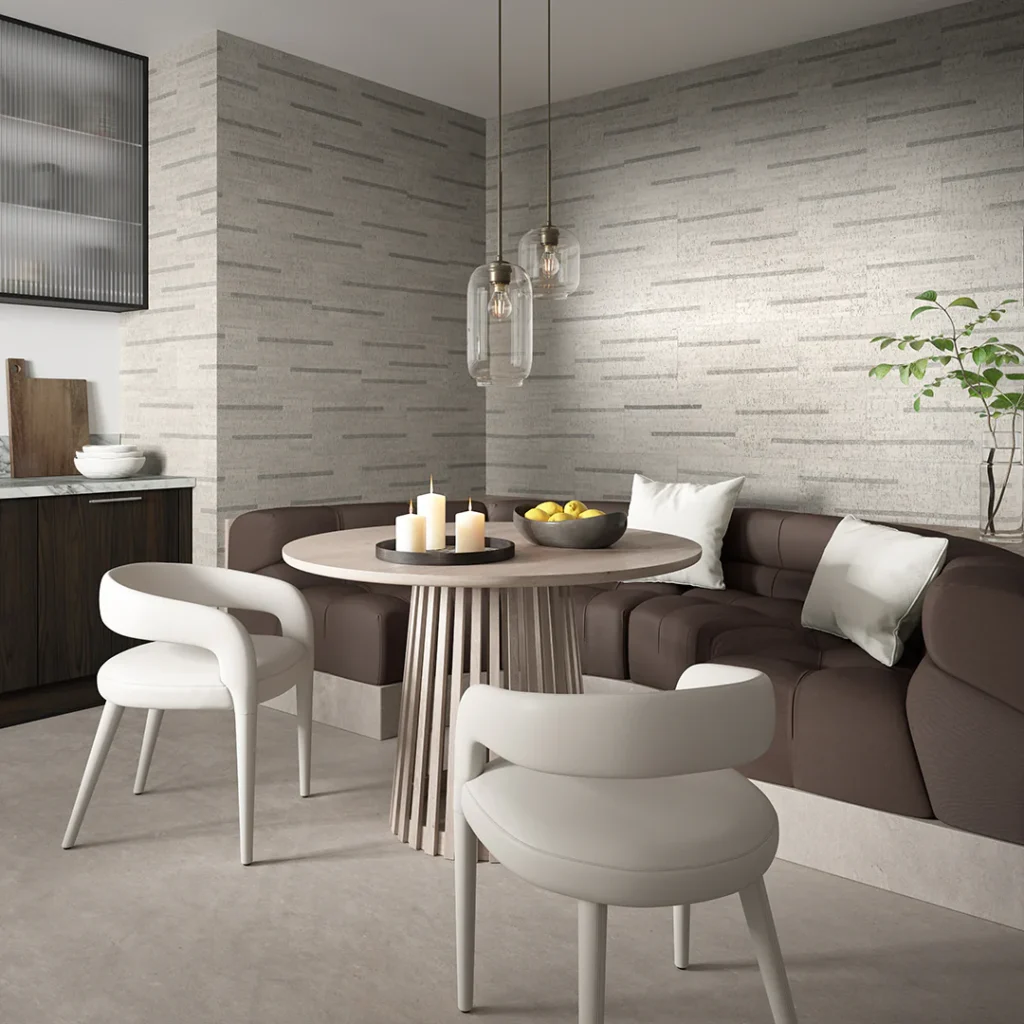
While Japandi interiors favor simplicity, subtle textured walls add a layer of interest and warmth without overwhelming the space.
Consider plaster or lime wash finishes in soft neutrals that create a tactile, almost fabric-like surface.
This adds depth and dimension, making your dining room feel cozy and inviting without sacrificing minimalism.
Textured walls pair beautifully with natural wood elements and soft lighting, creating a balanced backdrop that complements your furniture and decor.
This kind of finish also helps absorb sound, enhancing the peaceful, calm atmosphere essential for relaxed dining and conversation.
12. Statement Wooden Ceiling Beams
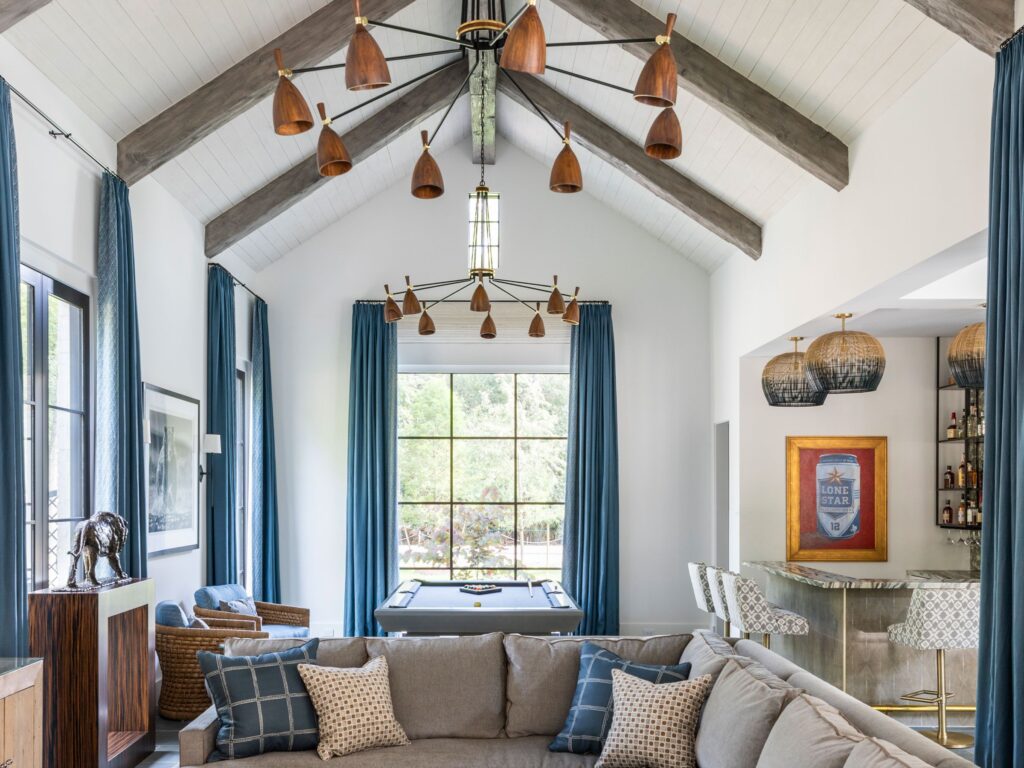
Exposed wooden ceiling beams introduce a striking architectural feature that ties the room’s natural elements together.
Choose beams in lighter woods like pine or oak to keep the space feeling bright and open.
These beams add rustic charm while maintaining the sleek simplicity of Japandi design.
They create visual interest above, drawing the eye upward and making the dining room feel more spacious.
Incorporating wooden beams is also a nod to traditional Japanese architecture, where natural materials are celebrated.
Their organic texture contrasts beautifully with smooth walls and minimalist furniture, enriching the overall harmony of the space.
13. Soft, Layered Textiles
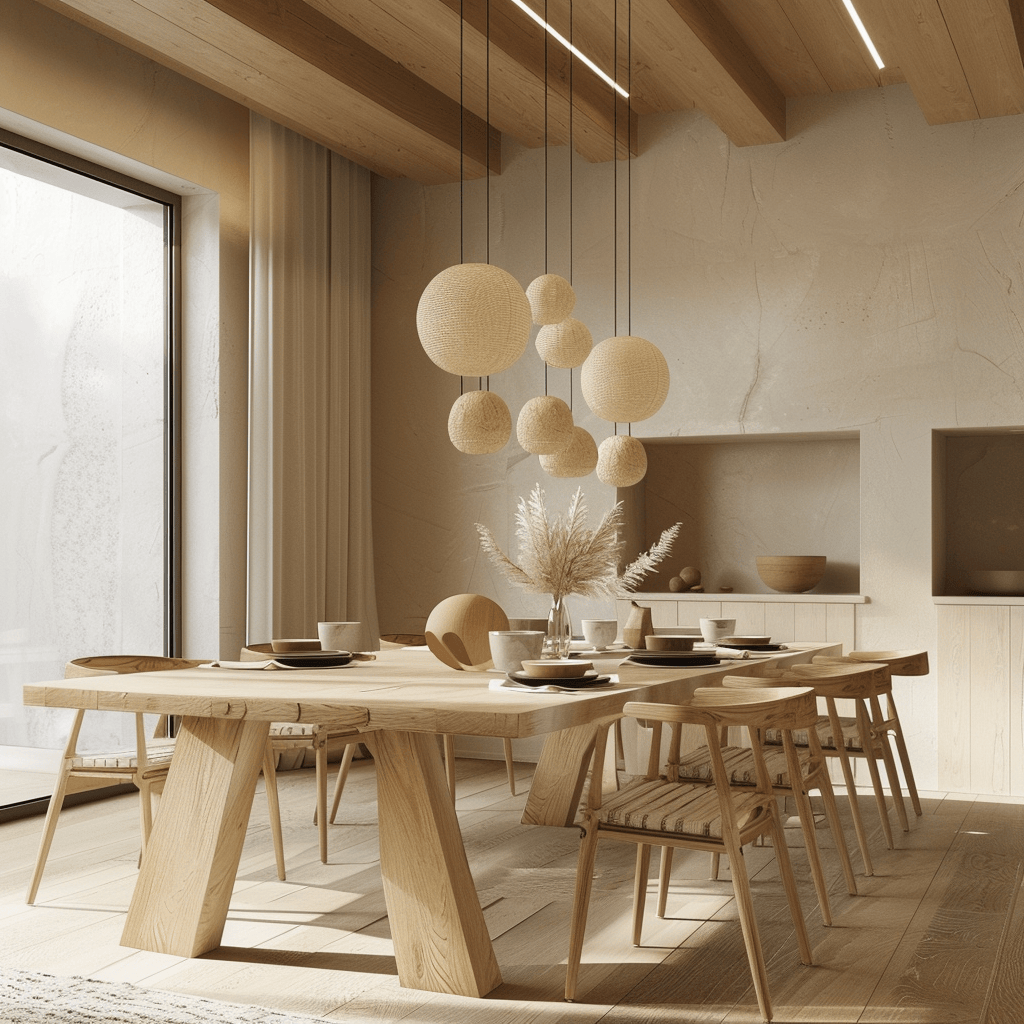
To soften the clean lines of your dining furniture and add tactile warmth, incorporate soft textiles such as cushions, throws, or seat pads.
Choose natural fabrics like linen, cotton, or wool in muted colors—think soft greys, warm taupes, or earthy greens.
Layering textiles creates visual depth and invites comfort, encouraging you and your guests to linger longer at the table.
Textiles also absorb sound, preventing the room from feeling too stark or echoey.
Japandi style celebrates understated comfort, and these cozy layers bring that ethos into your dining experience without disrupting the minimalist aesthetic.
14. Sliding Shoji Screens
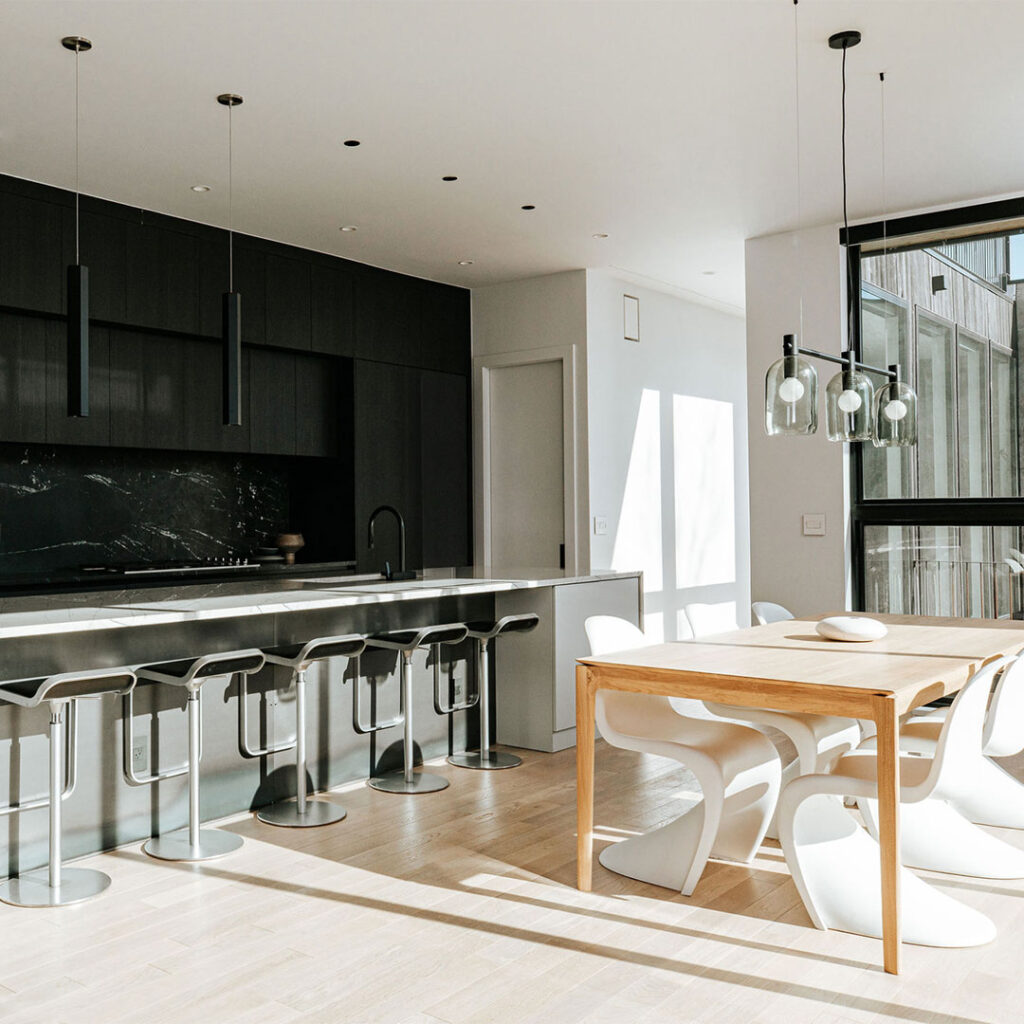
Shoji screens, iconic in Japanese interiors, bring versatility and elegance to Japandi dining rooms.
These lightweight sliding panels, made of wood and translucent paper or fabric, can be used to separate spaces or add a soft filter to natural light.
They maintain an open feel while offering privacy and a unique architectural element.
Incorporating Shoji screens adds cultural authenticity and helps you control the ambiance of your dining area.
They work particularly well in open-plan homes, creating flexible zones for dining without adding bulk.
Their delicate appearance balances beautifully with Scandinavian solidity, enhancing the fusion at the heart of Japandi design.
15. Incorporating Modern Patio Furniture for Indoor-Outdoor Flow

Many Japandi dining rooms emphasize connection to the outdoors, making modern patio furniture an ideal extension of your indoor space.
If your dining room opens onto a back porch or patio, choose sleek, minimalist furniture with natural materials and neutral tones.
This creates a seamless flow between indoor and outdoor living, a core concept in Japandi style.
Incorporate outdoor cushions or throws in soft fabrics that echo your indoor textiles to unify both spaces.
This setup invites relaxed dining experiences that blur the line between inside and outside, enhancing your home’s sense of calm and openness.
Plus, having stylish modern patio furniture ready for al fresco meals expands your dining possibilities, embracing nature and fresh air.
Conclusion: Crafting Your Dream Japandi Dining Room
Japandi dining room design is all about balance—between function and beauty, tradition and modernity, simplicity and warmth.
By focusing on natural materials, neutral colors, and thoughtful, handcrafted details, you create a space that’s not only visually stunning but also deeply inviting and comfortable.
From the grounding presence of a natural wood table to the delicate elegance of sliding Shoji screens, each element contributes to a harmonious environment where meals become moments of connection and mindfulness.
Whether you’re drawn to low-profile furniture that encourages intimacy or the tactile warmth of layered textiles, these Japandi ideas offer a blueprint for transforming your dining room into a serene retreat.
And by considering how your indoor space flows into outdoor living areas—perhaps with modern patio furniture—you extend this tranquil aesthetic beyond your walls, embracing light, nature, and calm in every corner.
So, take inspiration from these designs, trust your instincts, and enjoy the process of creating a Japandi dining room that’s uniquely yours: a place where beauty meets simplicity, and where every meal feels like a peaceful celebration.




